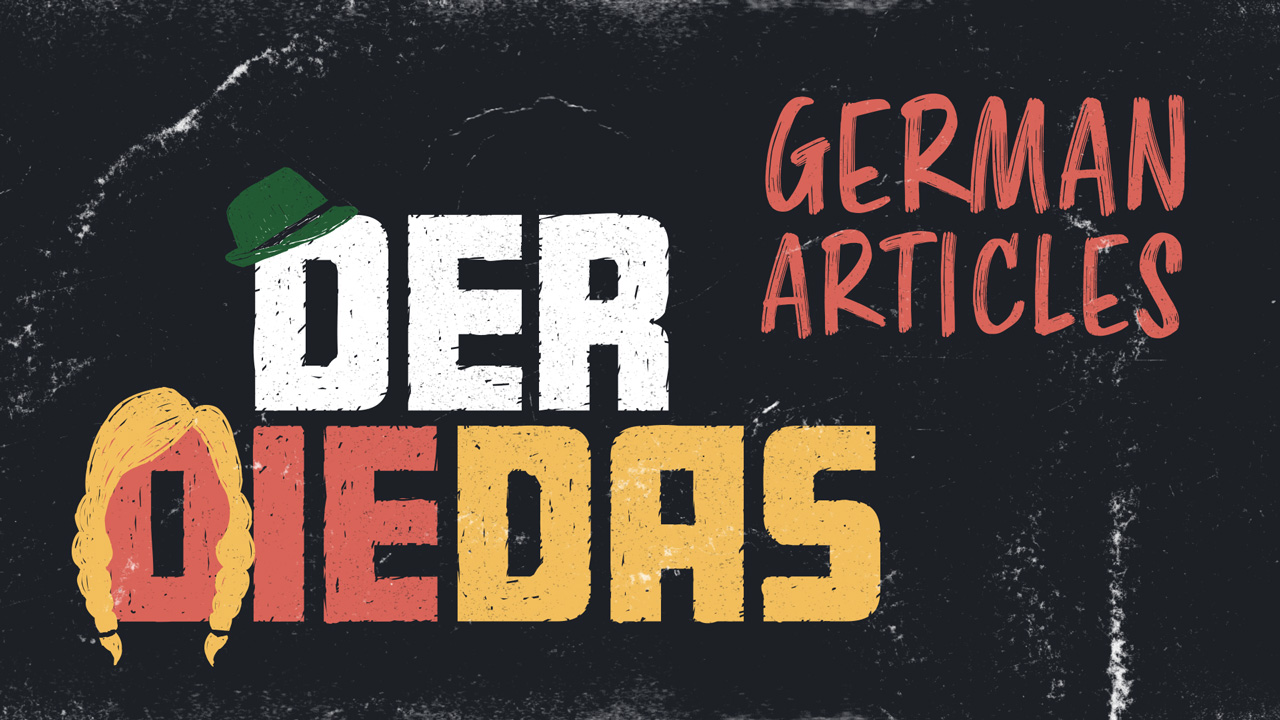German Articles – Everything You Need to Know [with Charts]
German articles – that is, the German for “the” and “a” – are very different than in English. Every article must agree with its noun in both gender and case, and if you get it wrong it can change the meaning of your sentence.
Here’s what I’ll cover in this guide:
Table of contents
- German Article Charts
- Gender in German Articles
- Cases in German Articles
- When to Use Each German Case
- The Nominative Case in German – Der/Die/Das
- The Accusative Case in German – Den/Die/Das
- Plural Articles in German
- How to Remember the German Articles
- How English Pronouns Can Help You Remember German Articles (and Visa Versa)
- How to Pronounce the German Articles
There are three genders in German: masculine (männlich), feminine (weiblich) or neutral (sächlich). There are also four cases: nominative, accusative, dative and genitive. To translate “a” or “the” into German, you must choose the correct entry from the following German article charts:
German Article Charts
German Definite articles (the)
| Masculine | Neutral | Feminine | Plural | |
|---|---|---|---|---|
| Nominative | der | das | die | die |
| Accusative | den | das | die | die |
| Dative | dem | dem | der | den |
| Genitive | des | des | der | der |
German Indefinite articles (a/an)
| Masculine | Singular | Feminine | Plural | |
|---|---|---|---|---|
| Nominative | ein | ein | eine | -eine |
| Accusative | einen | ein | eine | -eine |
| Dative | einem | einem | einer | -einen |
| Genitive | eines | eines | einer | -einer |
| Masculine | Singular | Feminine | Plural | |
|---|---|---|---|---|
| Nominative | mein | mein | meine | meine |
| Accusative | meinen | mein | meine | meine |
| Dative | meinem | meinem | meiner | meinen |
| Genitive | meines | meines | meiner | meiner |
Unsure how to use these charts? Don’t worry: this article will explain everything you need to know. The two critical concepts to understand are: gender and case.
Gender in German Articles
Like most European languages, German has genders. Three of them, to be precise. Every noun is categorised as either masculine (männlich), feminine (weiblich) or neutral (sächlich).
To use a noun correctly, you must know its gender.
Look at these examples, and notice how I use a different article (der/die/das) depending on the noun’s gender:
- der Hund (the dog) is a masculine noun
- die Frau (the woman) is a feminine noun
- das Boot (the boat) is a neutral noun (as well as the name of a classic German movie)
(Remember that all German nouns are always written with a capital letter.)
You need to remember the gender of every German noun that you learn. Don’t be discouraged: it’s easier than it looks. There are many time-saving shortcuts you can learn: for example, that all words which end in -heit, -keit, -schaft, -ung, and -tion are feminine.
See here for a comprehensive guide to remembering noun genders in German.
Cases in German Articles
You’ll be familiar with grammatical gender if you’ve studied a Romance language like French or Spanish. German, however, goes a step further: as well as a gender, each noun has a case: nominative, accusative, dative and genitive.
(It could be worse: Hungarian has a whopping eighteen cases!)
Unlike its gender, a noun’s case isn’t fixed. So for example, while Hund is always masculine, it can be any of the four cases depending on the context. Case conveys meaning: it tells you something about what the noun is doing (or what it had done to it) in relation to the other elements of the sentence.
You may be surprised to learn that English has cases too. Once upon a time, English had a case system as rich as German’s, but it’s mostly lost. The one place it survives is in pronouns, and to see what I mean consider the following sentences. Do they sound correct?
- Him kissed Sarah.
- Sarah kissed he.
Nope. He and him are the wrong way around. Both words refer to a male individual, but you need to use the correct one depending on whether “he” is the subject or the object of the sentence. That’s like a simplified version of how case works in German.
When to Use Each German Case
As mentioned above, the word for “dog” is Hund, a masculine noun. Looking at the chart, we can see that there are four ways of translating “the dog”: der Hund, den Hund, dem Hund or des Hund. Which case should we use?
The Nominative Case in German – Der/Die/Das
The nominative case is used for the subject of the sentence. The subject is the person or thing that is doing or performing the described action:
- der Hund beißt ihn – “the dog bites him”
- die Frau ist schön – “the woman is pretty”
- das Boot sank – “the boat sank”
The Accusative Case in German – Den/Die/Das
The accusative case is used for the direct object of the sentence. The direct object is the person or thing that the action is being done to:
- der Mann beißt den Hund – “the man bites the dog”
- der Hund beißt die Frau – “the dog bites the woman”
- der Mann rudert das Boot – “the man rows the boat”
Notice how the feminine and neutral articles haven’t changed. It’s only the masculine gender where there’s a visible difference between the nominative and accusative article.
Case allows German to be more flexible with its word order than is possible in English. For example, compare “the dog bites the man” with der Hund beißt den Mann.
In English, if you swap things around you get “the man bites the dog”, which completely changes the meaning. In German, however, the articles der and den contain information about who is doing the biting. So you can say den Mann beißt der Hund and it still means the same thing as the original sentence.
The Dative Case in German – Dem/Dem/Der
The dative case is a little bit more complicated. It’s generally used for indirect objects. For example, in the English sentence “I gave a present to John”, “a present” is the direct object and “John” is the indirect object.
Sometimes (but not always) you can translate the dative article as “to the” or “to a”. You must also use the dative after certain prepositions like mit (with) or aus (out).
- Ich gab dem Hund einen Knocken. – “I gave the dog a bone.” (Or “I gave a bone to the dog”.)’
- Ich kam mit der Frau. – I came with the woman.
- Ich zog ihn aus dem Boot. – I pulled him out of the boat.
A small number of verbs always take a dative object:
- antworten – “to answer”
- danken – “to thank”
- gehören – “to belong to”
- gefallen – “to like” (more literally: “to be pleasing to” or “to be liked by”)
- glauben – “to believe”
- helfen – “to help”
For example:
- Ich glaube nicht der Frau. – “I don’t believe the woman.”
- Er gefällt nicht dem Hund. – “The dog doesn’t like him.” (lit: “He is not pleasing to the dog.”)
The Genitive Case in German – Des/Des/Der
Finally, the genitive case denotes possession. It’s similar to the ‘s construction in English, and in fact. the two have the same origin. (The English “apostrophe and s” construction is sometimes called the Saxon genitive.)
Generally, when a masculine or neutral noun is genitive you also need to add -s or -es on the end, e.g. der Hund becomes des Hundes. There are some other situations in which you might need to change the noun’s ending; see here for a detailed guide.
- Der Knochen des Hundes – “the dog’s bone”
- Das Kleid der Frau – “the woman’s dress”
- Der Kapitän des Bootes – “the boat’s captain”
This only a brief overview of how cases work in German. There are various subtleties I haven’t covered. However, the above should be more than enough for a beginner.
Plural Articles in German
You may have noticed that the der/die/das chart above has a fourth column labelled “plural”. This is a strange thing about German: all nouns use the same articles when plural, regardless of gender.
So for example, when you want to talk about “the dogs”, “the women” or “the boats” in the nominative case, the article is always die, even though these nouns all have different genders. (die Hunde, die Frauen, die Boote.) For the accusative, dative and genitive it’s die, den and der respectively.
Another important point: the German indefinite article has no plural. Just like there’s no plural form of “a” in English (you can’t say “a dogs”), there’s no plural form of “ein” in German.
So why does the indefinite article chart have a “plural” column? Well, the entries in this column aren’t real articles. Instead, they tell you how to construct the plural forms of certain related words like kein and mein.
For example, mein is a possessive adjective meaning “my”, and it’s declined exactly like ein:
| Masculine | Singular | Feminine | Plural | |
|---|---|---|---|---|
| Nominative | mein | mein | meine | meine |
| Accusative | meinen | mein | meine | meine |
| Dative | meinem | meinem | meiner | meinen |
| Genitive | meines | meines | meiner | meiner |
Can you see how each entry in this chart is exactly the same as the equivalent entry for “ein”, except with an extra “m” in front? Unlike “ein” or “eine” in German, there’s no reason why mein can’t be used with a plural noun, like meine Hunde (“my dogs”).
This is why you need to learn the plural endings for the indefinite article. They’re not valid words in their own right, but they’re used to construct other important words.
How to Remember the German Articles
Let’s have another look at the chart for German definite articles:
| Masculine | Neutral | Feminine | Plural | |
|---|---|---|---|---|
| Nominative | der | das | die | die |
| Accusative | den | das | die | die |
| Dative | dem | dem | der | den |
| Genitive | des | des | der | der |
There are sixteen positions on the chart (three genders plus plural, and four cases), but, as you’ve probably noticed, there aren’t sixteen different definite articles. In fact, there are only six (das, dem, den, der, des, die). The following observations might help you remember what goes where:
- das is always neutral (nominative or accusative)
- dem is always dative (masculine or neutral)
- den is either masculine accusative or plural dative
- der is either masculine nominative, plural genitive, feminine dative or feminine genitive
- des is always genitive (masculine or neutral)
- die is feminine or plural, and nominative or accusative
What about the indefinite articles?
| Masculine | Singular | Feminine | Plural | |
|---|---|---|---|---|
| Nominative | ein | ein | eine | -eine |
| Accusative | einen | ein | eine | -eine |
| Dative | einem | einem | einer | -einen |
| Genitive | eines | eines | einer | -einer |
Isn’t it annoying that you need to memorise two whole tables? Not so fast: if you take a closer look, you’ll notice that there are a lot of similarities in the way the two charts are organised.
Just follow these rules:
- Replace the nominative masculine der, and both instances of das, with ein.
- Replace die with eine. It helps if you remember that they both end with “e”.
- For everything else, change the d- to ein-. So des becomes eines, dem becomes einem, etc..
Do you see the logic?
This means that learning both sets of German articles is easier than it might initially have looked. Once you’ve learned the definite articles, it’s easy to remember the indefinite articles.
How English Pronouns Can Help You Remember German Articles (and Visa Versa)
Have you spotted the similarities between German case declensions and certain features of English? English is, after all, German’s cousin. They’re both descended from proto-Germanic, an extinct language thought to have been spoken in Scandinavia roughly 2,500 years ago.
I already mentioned the obvious similarity between the German genitive and the English “Saxon genitive”. Compare, for example, des Hundes and des Boots with “the hound’s” and “the boat’s”.
But you can also see echoes of German in certain English pronouns. For example, “him”, “them”, and “whom” all end in “-m”, just like the German dem. And they’re used in roughly the same situations: dem is a dative article, and you usually use (say) “them” in the situations that would call for a dative in German.
Many native English speakers are unsure when to use “who” and when to use “whom”. If you master German cases, it will probably help you with your English grammar as well!
How to Pronounce the German Articles
Remember that the ie in German is pronounced like an English ee as in “see”, and ei is pronounced like the English “eye”.
So the article ein rhymes with “mine”. Die in German is pronounced like “dee”, not like the English word “die”. Remember this classic Simpsons joke:
Other than that, the articles are pronounced how you’d expect based on the spelling. The only thing to watch out for is the difference between -e and -er (as in eine vs. einer), which can be tricky. The explanation and audio recordings on this page should help you figure it out.










Social